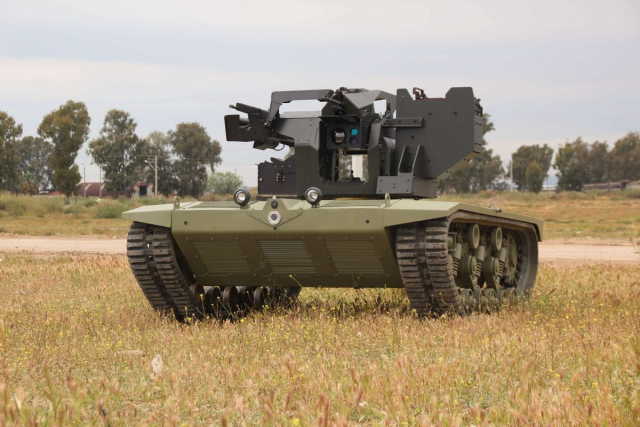Digitalization and robotization of the Turkish Armed Forces. Part III.Continuing the topic of the development of digital technologies and robotic complexes (RTK) in the Turkish Armed Forces, we recall that in part I it was about the achievements of the Turkish military-industrial complex in the field of swarm technologies.
Part II concerned the production of unmanned aerial vehicles. Now let's turn to ground systems.
Ground-based robotic systems
According to Turkish sources, in the last decade, the development of ground-based RTCs has significantly benefited from new technologies. Although they are currently primarily remotely operated vehicles, it is expected that in the near future ground-based RTCs will begin to carry out missions independently.
A few years ago, the Turkish Defense Industry Administration (SSB) approved a plan for the development of ground-based RTCs. According to the document, it is envisaged that this group of technical means will receive the following capabilities: autonomy, mobility, combat capability and the necessary logistical support. By weight, ground RTCs are divided into three categories: light, medium and heavy.
Lightweight robotic systems
The light category includes tactical robots weighing from 1 to 6 kg. As a rule, such systems are used in urban environments to perform a wide range of tasks: from conducting reconnaissance to clearing ammunition and IEDs.
Thus, the RTK M4 Mini from Alpera is a tracked platform in a compact and durable housing. The device has a mass of 2.2 kg and dimensions of 12x28x36 cm, which ensures its carrying in a standard backpack. The M4 is strong enough to continue its work even after falling to the concrete floor from a height of 6 m.
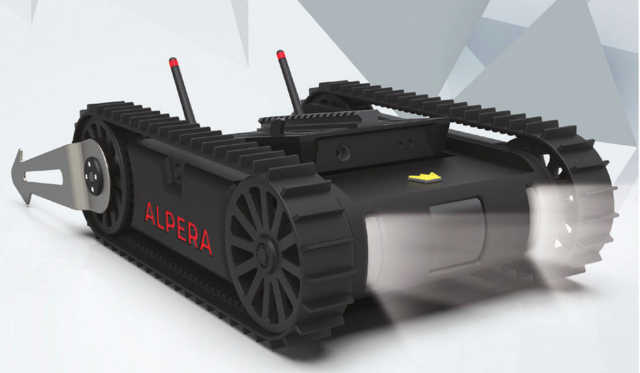
The M4 Mini robotics complex from AlperaThe design of this RTK ignores such definitions as front or back, top or bottom.
The device is operable in any direction. Thanks to its hooks, it can climb, pull, push or move objects. The duration of work in difficult conditions reaches 3 hours. The M4 Mini is equipped with 4 IR cameras and thus provides 360° situational awareness.
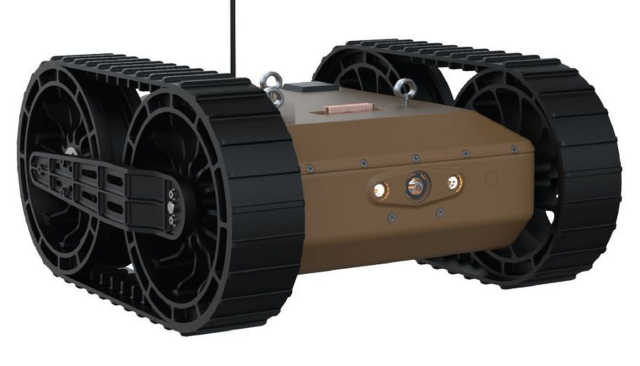
One-time RTK VAŞAK from Altınay Defense companyA wide range of applications is offered by the VAŞAK disposable ground RTK from Altınay Defense company.
The device has a long communication range and high impact resistance, which allows it to be used inside buildings and other enclosed spaces (for example, in caves). To survey any space, it is enough just to throw it there. The modular principle of payload acquisition makes VAŞAK relevant when performing mapping tasks, thermal observation, detection of damaging WMD factors.
The DEGU portable robotic platform from Next Horizons is designed to perform reconnaissance and surveillance missions, indoors and outdoors. The device itself weighs 1.5 kg. The modular design allows the RTK to be equipped with a payload weighing up to 2.5 kg. The capacity of the batteries ensures continuous operation for 2-3 hours.
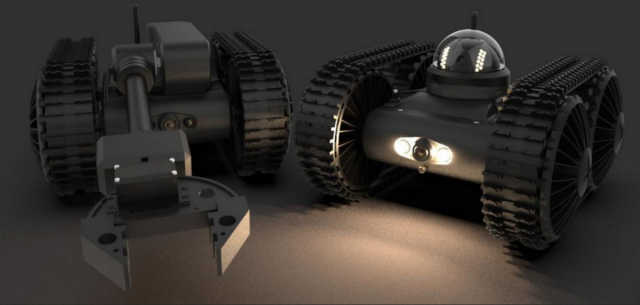
DEGU robotic platform from Next HorizonsInformation regarding specific models in the light category, marked by the Turkish Defense Ministry, has not yet been made public.
Nevertheless, it is obvious that the choice is quite wide, since a sufficient number of enterprises work in this segment.
RTK of the average weight category
Regarding medium-heavy robots, SSB has two standard sizes: 500 kg and 2.5 tons. In the first subgroup, 4 models were included in the final selection for the Turkish Ground Forces: "Aslan" from Aselsan, "Barkan" from Havelsan, "Fedai" from Best Group and "HANCER" from Elektroland Defense.
All four ground-based RTCs are equipped with optoelectronic sensors that provide circular monitoring of the situation, and data transmission systems that guarantee a range of up to 1500 m from the operator, including maintaining controllability at a distance of up to 300 m out of line of sight. The duration of continuous operation is up to 6 hours. As a payload, either a remotely controlled SARP weapon station from Aselsan with a 7.62 mm machine gun installed, or a manipulator for IED neutralization is used. All RTCs meet the requirements of a digital interface compatible with the Turkish Soldier of the Future system. The final tests of the models were planned to be completed in 2021. After that, their mass production was expected to begin.
According to the SSB requirements, ground-based RTCs from a subgroup of 2.5-ton vehicles should be suitable for reconnaissance and target designation. In addition, due to their size and carrying capacity, they can be used to transport cargo and, if necessary, wounded, carry heavy weapons systems, for example, anti-tank missile systems. The announcement of the tender in this subgroup was planned for 2021. As reported, interested companies have already submitted their applications. Among them, observers stand out the tracked remotely controlled weapons platform "UKAP" (UKAP) from Katmerciler and the 8x8 wheeled RTC "Alkar R8" (ALKAR R8) from Alpera Defense Systems, which debuted at IDEF 21.
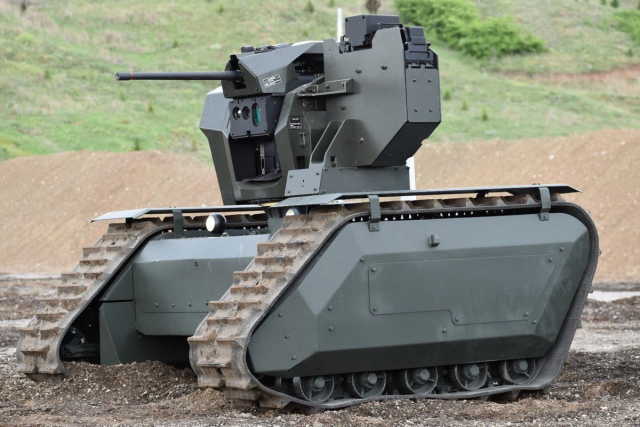
Katmerciler's UKAP crawler platformThe manufacturer positions its development "Ukap" as a basic platform for the installation of weapons.
During the tests and military exercises, the same remotely controlled SARP weapon station from Aselsan was used with a 12.7 or 7.62 machine gun installed. RTC "Ukap" has dimensions of 2,6x0,85x2,1 m. With its own weight of 2 tons, it can carry up to 1 ton of payload and reach speeds of up to 20 km/h over rough terrain. The design allows you to install electric or hybrid engines. In the first case, the duration of work will be at least 5 hours, in the second – up to 8 hours. The control is carried out from a mobile remote control at a distance of up to 3 km. In the case of using satellite communication channels, the range is not limited. In this case, it is also possible to manage multiple platforms. "Ukap" is designed to perform a wide range of tasks, in particular: patrolling terrain areas, conducting reconnaissance using IR cameras or motion sensors, neutralizing ammunition and IEDs. The RTK is equipped with bulletproof armor, which provides additional protection and can be used, for example, to evacuate victims from conflict areas.
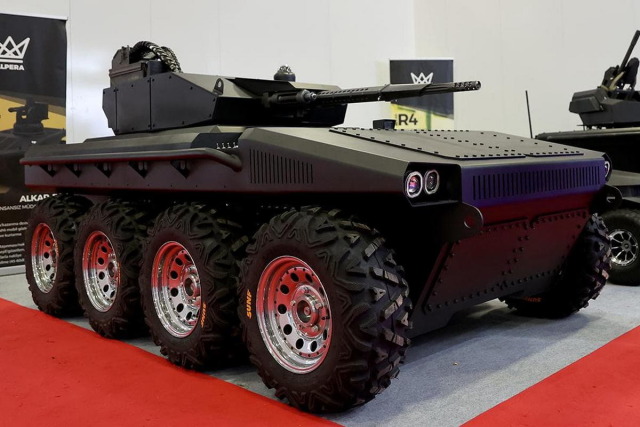
Wheeled 8x8 RTC ALKAR R8 from AlperaThe information representation in the open sources of the RTC "Alkar R8" is rather poor.
It is known that this is an 8-wheel fully electric robot with a diesel generator with a capacity of 10 MW and a range of up to 60 km. RTK has security up to the 3rd and 4th levels. The sample presented at the exhibition was armed with a 20 mm automatic cannon. The modular design allows you to change the level of protection and payload in accordance with the needs of the user and the conditions of the situation.
RTK heavy weight category
Vehicles weighing from 14 to 25 tons are classified as heavy ground-based robotic complexes. As a rule, this is a wheeled or tracked vehicle designed to perform a wide range of tasks and suitable for use in manned or unmanned versions.
First of all, Turkish sources note 4×4 armored fighting vehicles, namely: "EJDER YALÇIN" (EJDER YALÇIN) from Nurol Makina, "KIRPI II" (KIRPI II) and "Amazon" (AMAZON) produced by BMC. A feature of the unmanned version of the Amazon armored car is its equipment with the LIDAR system, which in three dimensions allows you to detect obstacles and determine the distance to them using a laser.
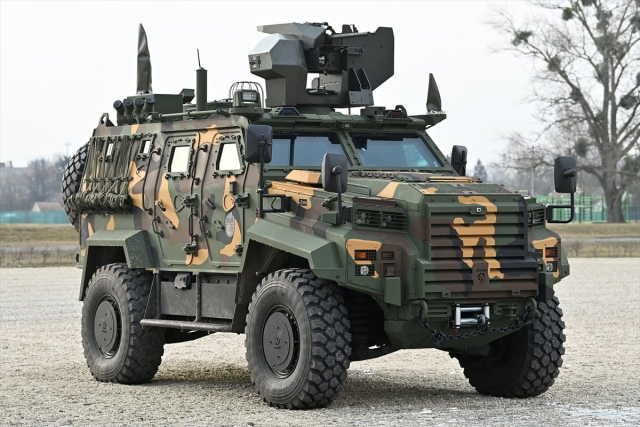
EJDER YALÇIN armored vehicle from Nurol Makina companyIn the unmanned version, these platforms are planned to be used in dangerous areas to perform logistical tasks, conduct reconnaissance, as well as as carriers of a diverse arsenal of weapons.
The latter, combined with the high mobility of the wheeled chassis, open up broad prospects for operational interaction with the combat units of the Turkish Ground Forces.
Among the exhibits of IDEF 21, Turkish military experts highlighted the FNSS RTK, called SHADOW RIDER ("Shadow Rider", hereinafter referred to as "Rider"). The device is made on the tracked base of the M113 armored personnel carrier. Combat weight reaches 13,500 kg. Payload – not less than 4500 kg. Dimensions: 5.5x3.0x2.0 m. The engine is diesel. On the road, the Rider is able to reach speeds of up to 50 km/ h and has a power reserve of 450 km. The exhibition sample was completed with a 20 mm automatic cannon mounted in the turret.
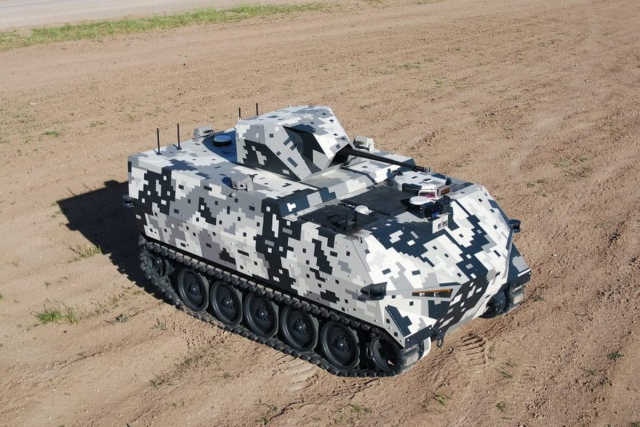
RTK SHADOW RIDER produced by FNSSThe manufacturer positions the Rider as a system solution that facilitates the soldier's role on the battlefield and is designed to become a force multiplier for the user across the entire range of missions.
The Rider is equipped with an autonomy kit developed by FNSS. The autonomy kit is supported by AI and has several operating modes: patrolling, following the leader and returning to the military base. The kit is designed on the principle of open architecture, which guarantees rapid adaptation of new technological developments.
In the armed version, the "Rider" is designed to provide fire support. At the same time, the operator gives the command to open fire remotely. It is believed that in addition to fire support, SHADOW RIDER is suitable for conducting reconnaissance and surveillance, logistics, working as a repeater, conducting tactical deception operations and evacuating victims.
To be continued…Based on the materials of the European Security & Defense magazine
